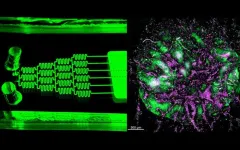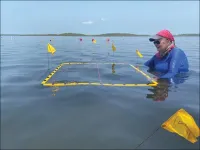(Press-News.org) To better understand why some cancer patients struggle to fight off infections, Georgia Tech researchers have created tiny lab-grown models of human immune systems.
These miniature models — known as human immune organoids — mimic the real-life environment where immune cells learn to recognize and attack harmful invaders and respond to vaccines. Not only are these organoids powerful new tools for studying and observing immune function in cancer, their use is likely to accelerate vaccine development, better predict disease treatment response for patients, and even speed up clinical trials.
“Our synthetic hydrogels create a breakthrough environment for human immune organoids, allowing us to model antibody production from scratch, more precisely, and for a longer duration,” said Ankur Singh, Carl Ring Family Professor in the George W. Woodruff School of Mechanical Engineering and professor in the Wallace H. Coulter Department of Biomedical Engineering at Georgia Tech and Emory.
“For the first time, we can recreate and sustain complex immunological processes in a synthetic gel, using blood, and effectively track B cell responses,” he added. “This is a gamechanger for understanding and treating immune vulnerabilities in patients with lymphoma who have undergone cancer treatment — and hopefully other disorders too.”
Led by Singh, the team created lab-grown immune systems that mimic human tonsils and lymph node tissue to study immune responses more accurately. Their research findings, published in the journal Nature Materials, mark a shift toward in vitro models that more closely represent human immunology. The team also included investigators from Emory University, Children’s Hospital of Atlanta, and Vanderbilt University.
Designing a Tiny Immune System Model
The researchers were inspired to address a critical issue in biomedical science: the poor success rate of translating preclinical findings from animal models into effective clinical outcomes, especially in the context of immunity, infection, and vaccine responses.
“While animal models are valuable for many types of research, they often fail to accurately mirror realistic human immune biology, disease mechanisms, and treatment responses,” said Monica (Zhe) Zhong, a Bioengineering Ph.D. student and the paper’s first author. “To address this, we designed a new model that faithfully replicates the unique complexity of human immune biology across molecular, cellular, tissue, and system levels.”
The team used synthetic hydrogels to recreate a microenvironment where B cells from human blood and tonsils can mature and produce antibodies. When immune cells from healthy donors or lymphoma patients are cultured in these gel-like environments, the organoids support longer cell function, allowing processes like antibody formation and adaptation to occur — similar to the human body. Utilizing the organoids for individual patients helps predict how that individual will respond to infection.
The models also enable researchers to control and test immune responses under various conditions. The team discovered that not all tissue sources are the same, and tonsil cells struggled with longevity issues. They used a specialized setup to study how healthy immune cells react to signals that help them fight infections, which failed to trigger the same response in cells from lymphoma survivors who seemingly have recovered from immunotherapy treatment.
Using organoids embedded in a novel immune organ-on-chip technology, the team observed that immune cells from lymphoma survivors treated with certain immunotherapies do not organize themselves into specific “zones,” the way they normally would in a strong immune response. This lack of organization may help explain some immune challenges cancer survivors face, as evidenced by recent clinical findings.
A Game-Changing Technology
This research is primarily of interest to infectious disease researchers, cancer researchers, immunologists, and healthcare professionals dedicated to improving patient outcomes. By studying these miniature immune systems, they can identify why current treatments may not be effective and explore new strategies to enhance immune defenses.
"Lymphoma patients treated with CD20-targeted therapies often face increased susceptibility to infections that can persist years after completing therapy.Understanding these long-term impacts on antibody responses could be key to improving both safety and quality of life for lymphoma survivors,” said Dr. Jean Koff, associate professor in the department of Hematology and Oncology at Emory University’s Winship Cancer Institute and a co-author on the paper.
“This technology provides deeper biological insights and an innovative way to monitor for recovery of immunological defects over time. It could help clinicians better identify patients who would benefit from specific interventions that reduce infection risk,” Koff added.
Another critical and promising aspect of the research is its scalability: An individual researcher can make hundreds of organoids in a single sitting. The model’s capability to target different populations — both healthy and immunosuppressed patients — vastly increases its usability for vaccine and therapeutic testing.
According to Singh, who directs the Center for Immunoengineering at Georgia Tech, the team is already pushing the research into new dimensions, including developing cellular therapies and an aged immune system model to address aging-related questions.
“At the end of the day, this work most immediately affects cancer patients and survivors, who often struggle with weakened immune responses and may not respond well to standard treatments like vaccines,” Singh explained. “This breakthrough could lead to new ways of boosting immune defenses, ultimately helping vulnerable patients stay healthier and recover more fully.”
The work was initially funded by the Wellcome Leap HOPE program. This support has led to a boost in recent funding, including a recent $7.5M grant from the National Institute of Allergy and Infectious Diseases.
Citation: Zhong, Z., Quiñones-Pérez, M., Dai, Z. et al. Human immune organoids to decode B cell response in healthy donors and patients with lymphoma. Nat. Mater. (2024).
DOI: https://doi.org/10.1038/s41563-024-02037-1
Funding: Wellcome Leap HOPE Program, National Institutes of Health, National Institute of Allergy and Infectious Diseases, National Cancer Institute, and Georgia Tech Foundation
#####
The Georgia Institute of Technology, or Georgia Tech, is one of the top public research universities in the U.S., developing leaders who advance technology and improve the human condition. The Institute offers business, computing, design, engineering, liberal arts, and sciences degrees. Its more than 45,000 undergraduate and graduate students, representing 50 states and more than 148 countries, study at the main campus in Atlanta, at campuses in France and China, and through distance and online learning. As a leading technological university, Georgia Tech is an engine of economic development for Georgia, the Southeast, and the nation, conducting more than $1 billion in research annually for government, industry, and society.
END
Lab-grown human immune system uncovers weakened response in cancer patients
The miniature models could exponentially accelerate vaccine development, cancer treatment research, and improved health outcomes across a spectrum of diseases.
2024-11-12
ELSE PRESS RELEASES FROM THIS DATE:
More than 5 million Americans would be eligible for psychedelic therapy, study finds
2024-11-12
Acupuncture. Ketamine infusions. “Electroshock” or electroconvulsive therapy. The existing treatment options for those diagnosed with Major Depressive Disorder (MDD) and Treatment-Resistant Depression (TRD), may sometimes feel daunting or expensive alternatives to medication. However, a groundbreaking study from Emory University demonstrates how psilocybin-assisted therapy could impact more than 5 million people in the U.S. pending approval from the FDA.
The findings highlight both the ...
Children’s Hospital of Philadelphia researchers find community health workers play critical role in coordinating asthma care across home, school and community
2024-11-12
While great strides have been made to ensure children have access to proper asthma care in their home and community, linking those environments to the care that children receive while in school has been a challenge. In a new study, researchers from Children’s Hospital of Philadelphia (CHOP) demonstrate that community health workers can play a critical role in integrating all environments where children encounter asthma triggers, and care coordination provided by these workers may be a cost-effective way to achieve that. The findings were recently published by JAMA ...
Comprehensive Genomic Profiling leads to better patient outcomes, new joint study says
2024-11-12
RENTON, Wash. [Nov. 12, 2024] – New real-world data from Providence, Illumina (NASDAQ: ILMN), and Microsoft Research reveals that Comprehensive Genomic Profiling (CGP), when done early in a cancer patient’s diagnosis, leads to better personalized treatment and patient outcomes. The findings come out of the first two years of a five-year, real-world study, which was published today in the Journal of Clinical Oncology - Oncology Practice (JCO-OP).
Through a novel approach, the study employed pathologist-driven CGP testing ...
Animated movie characters with strabismus are more likely to be villains, study finds
2024-11-12
Strabismus, a misalignment of the eyes that occurs especially in children, has no bearing on intelligence or personality, but animated movies tend to use the condition to signify a villainous, dopey, or clumsy character, according to a new study from researchers at the University of Colorado School of Medicine.
“When animators are figuring out what a character is going to look like, they have to decide on every little detail of that character's appearance, and so it's not by chance that an animated character happens to have strabismus,” says Michael ...
How retailers change ordering strategy when a supplier starts its own direct channel
2024-11-12
Researchers from Erasmus University and KU Leuven published a new Journal of Marketing study that examines how retailers respond when suppliers establish direct channels to reach end-consumers and how suppliers can take steps to avoid a backlash.
The study, forthcoming in the Journal of Marketing, is titled “How Retailers Change Ordering Strategies When Suppliers Go Direct” and is authored by Michiel Van Crombrugge, Els Breugelmans, Femke Gryseels, and Kathleen Cleeren.
Recently, Sony began selling PlayStation products through its PlayStation Direct online store in the UK, ...
Young coral use metabolic tricks to resist bleaching
2024-11-12
Coral larvae reduce their metabolism and increase nitrogen uptake to resist bleaching in high temperatures, according to a study published November 12th in the open-access journal PLOS Biology by Ariana S. Huffmyer of the University of Washington, US, and colleagues.
High ocean temperatures cause coral bleaching, which results from the disruption of the relationship between corals and their symbiotic algae, an increasing concern as global temperatures rise. However, relatively little research has examined the effects of high temperatures ...
Protecting tax whistleblowers pays off
2024-11-12
AUSTIN, Texas — The federal tax gap — money people and companies owe Uncle Sam but fail to pay on time — has climbed to historic highs: $696 billion in 2022, according to the IRS. It’s money that, if recouped, could fund infrastructure or education or pay down government debt.
One way to collect that money is through lawsuits prompted by corporate whistleblowers — often present or former employees who know a company’s finances and expose its transgressions.
Federal law includes ...
Bioluminescent proteins made from scratch enable non-invasive, multi-functional biological imaging
2024-11-12
Bioluminescence is the natural chemical process of light creation in some living creatures that makes fireflies flicker and some jellyfish glow. Scientists have long been interested in borrowing the secrets of these animals' light-producing genes to create similar effects in vertebrates, for a variety of biomedical applications.
UC Santa Cruz Assistant Professor of Biomolecular Engineering Andy Yeh is designing completely artificial proteins that produce bioluminescence to serve as a non-invasive method for bioimaging, diagnostics, drug discovery, and more. A new paper published in the flagship journal Chem reports on a new series of bioluminescent ...
New study links air pollution with higher rates of head and neck cancer
2024-11-12
DETROIT — A recent study published in the journal Scientific Reports correlates higher levels of pollutant particulate matter to higher occurrences of head and neck aerodigestive cancer.
The article, "Air Pollution Exposure and Head and Neck Cancer Incidence," is the work of a multi-institutional collaboration with researchers from Wayne State University, Johns Hopkins University and Mass General Brigham.
The study was led by John Cramer, Ph.D., associate professor of otolaryngology, and John Peleman, M.D., medical resident in the Department of Otolaryngology, in the Wayne State University School of Medicine. They collaborated with Mass General Brigham, an integrated ...
LSU researchers excavate earliest ancient Maya salt works
2024-11-12
The team was led by LSU Alumni Professor Heather McKillop, who first discovered wooden buildings preserved there below the sea floor, along with associated artifacts, and the only ancient Maya wooden canoe paddle in 2004.
Her key collaborator, Assistant Professor Elizabeth Sills at the University of Texas at Tyler, began working with McKillop as a master’s student and then as a doctoral student at LSU.
Since their initial discovery of wood below the sea floor in Belize, the team has uncovered an extensive pattern of sites that include “salt kitchens” for boiling ...
LAST 30 PRESS RELEASES:
New expert guidance urges caution before surgery for patients with treatment-resistant constipation
Solar hydrogen can now be produced efficiently without the scarce metal platinum
Sleeping in on weekends may help boost teens’ mental health
Study: Teens use cellphones for an hour a day at school
After more than two years of war, Palestinian children are hungry, denied education and “like the living dead”
The untold story of life with Prader-Willi syndrome - according to the siblings who live it
How the parasite that ‘gave up sex’ found more hosts – and why its victory won’t last
When is it time to jump? The boiling frog problem of AI use in physics education
Twitter data reveals partisan divide in understanding why pollen season's getting worse
AI is quick but risky for updating old software
Revolutionizing biosecurity: new multi-omics framework to transform invasive species management
From ancient herb to modern medicine: new review unveils the multi-targeted healing potential of Borago officinalis
Building a global scientific community: Biological Diversity Journal announces dual recruitment of Editorial Board and Youth Editorial Board members
Microbes that break down antibiotics help protect ecosystems under drug pollution
Smart biochar that remembers pollutants offers a new way to clean water and recycle biomass
Rice genes matter more than domestication in shaping plant microbiomes
Ticking time bomb: Some farmers report as many as 70 tick encounters over a 6-month period
Turning garden and crop waste into plastics
Scientists discover ‘platypus galaxies’ in the early universe
Seeing thyroid cancer in a new light: when AI meets label-free imaging in the operating room
Neutrophil-to-lymphocyte ratio may aid risk stratification in depressive disorder
2026 Seismological Society of America Annual Meeting
AI-powered ECG analysis offers promising path for early detection of chronic obstructive pulmonary disease, says Mount Sinai researchers
GIMM uncovers flaws in lab-grown heart cells and paves the way for improved treatments
Cracking the evolutionary code of sleep
Medications could help the aging brain cope with surgery, memory impairment
Back pain linked to worse sleep years later in men over 65, according to study
CDC urges ‘shared decision-making’ on some childhood vaccines; many unclear about what that means
New research finds that an ‘equal treatment’ approach to economic opportunity advertising can backfire
Researchers create shape-shifting, self-navigating microparticles
[Press-News.org] Lab-grown human immune system uncovers weakened response in cancer patientsThe miniature models could exponentially accelerate vaccine development, cancer treatment research, and improved health outcomes across a spectrum of diseases.





